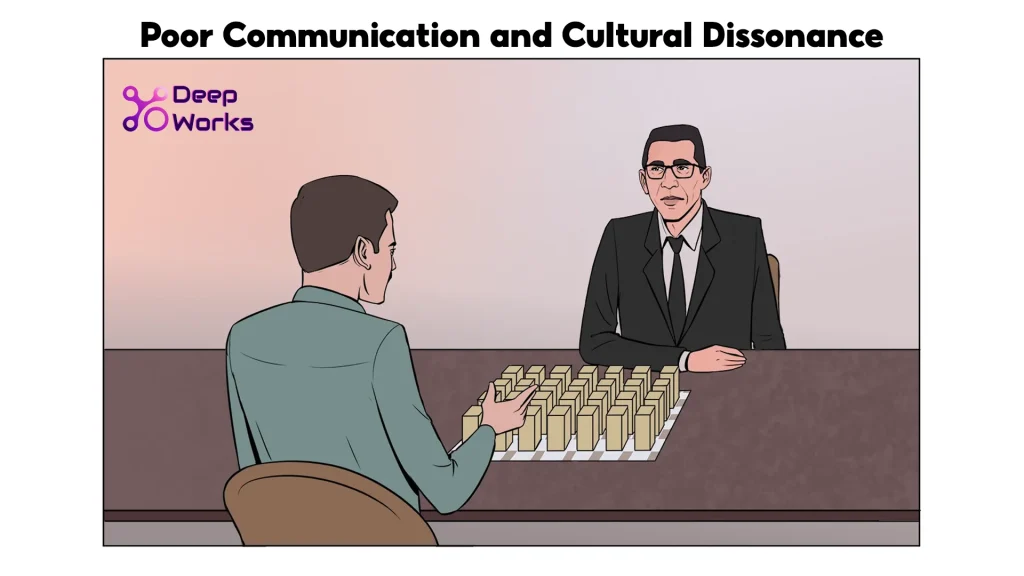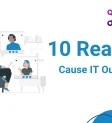The decision to outsource can feel like a strategic masterstroke, a direct path to innovation, efficiency, and growth. Yet, the landscape is littered with the remnants of partnerships that started with high hopes and ended in disaster. These outsourcing failures are more than just cautionary tales; they are critical business lessons.
While headlines often focus on the dramatic collapses, the reality is that many outsourcing relationships simply fizzle out, failing to deliver the promised value and leaving companies in a worse position than when they started. The good news? With the right knowledge and a proactive strategy, these common pitfalls are not just manageable—they’re avoidable.
This guide will walk you through the primary causes of outsourcing failures and provide a clear framework to ensure your next partnership is a resounding success.
The Allure and Alarming Reality of Outsourcing


Companies are drawn to outsourcing for a host of compelling reasons: reducing operational costs, gaining access to a global talent pool, and accelerating time-to-market.
The promise of leveraging specialized expertise from a partner like DeepWorks to build cutting-edge web applications or implement complex AI solutions allows internal teams to focus on core business objectives. It’s a powerful proposition.
However, the allure can mask a much harsher reality. Industry analysis consistently reveals sobering statistics. According to a report by Deloitte on their Global Outsourcing Survey, while cost reduction remains a primary driver, many organizations struggle to achieve the desired outcomes.
This gap between expectation and reality is where outsourcing failures are born, often stemming from overlooked outsourcing risks.
Common Misconceptions About Outsourcing
Before diving into the causes of failure, it’s crucial to dispel some persistent myths:
- “It’s always cheaper.” While cost savings are possible, hidden costs like vendor management, legal fees, and knowledge transfer can quickly erode the price advantage.
- “It’s a ‘fire-and-forget’ solution.” Successful outsourcing is not a handover; it’s a partnership that requires continuous management, communication, and engagement from the client-side.
- “Any process can be outsourced.” Core business functions that represent your unique value proposition often carry significant strategic risk when outsourced.
The High Cost of Getting It Wrong
A failed outsourcing venture is far more than a line item on a budget sheet. The consequences can be catastrophic and far-reaching:
- Financial Drain: Beyond the initial investment, you face budget overruns, costs of rework, and the potential expense of bringing a project back in-house or finding a new vendor.
- Reputational Damage: A botched project, a data breach, or poor customer service from your outsourced team can irrevocably damage your brand’s reputation.
- Intellectual Property Loss: Inadequately protected IP can be compromised or stolen, destroying your competitive advantage.
- Operational Disruption: A failing partnership can bring critical business processes to a grinding halt, impacting productivity and customer satisfaction.
Top 10 Reasons for Outsourcing Failures
Understanding why outsourcing partnerships fail is the first step toward building one that succeeds. While every situation is unique, most outsourcing failures can be traced back to a handful of recurring, critical mistakes.
1. Poor Communication and Cultural Dissonance


At the heart of any successful partnership is clear, consistent, and transparent communication. When you introduce different time zones, languages, and cultural norms into the mix, the potential for misunderstanding skyrockets. A simple “yes” can mean “I understand” in one culture and “I agree” in another.
These subtle yet critical differences in communication styles, work ethics, and approaches to hierarchy can lead to misaligned expectations, project delays, and immense frustration.
Quote: “The single biggest problem in communication is the illusion that it has taken place.” – George Bernard Shaw
Strategies for Effective Cross-Cultural Communication
- Establish a Communication Charter: Early on, agree on primary points of contact, preferred communication tools (Slack, Teams, etc.), and a fixed schedule for meetings that respects all time zones.
- Over-Communicate: Especially in the beginning, it’s better to provide too much context than not enough. Document everything—meeting notes, decisions, and action items should be shared and confirmed.
- Foster Cultural Awareness: Invest in basic cross-cultural training for your internal team. Understanding holidays, work etiquette, and communication nuances can prevent unnecessary friction. For a deeper dive, resources like the Centre for Intercultural Learning provide invaluable insights.
2. Inadequate Vendor Selection and Due Diligence


Choosing an outsourcing partner is one of the most critical decisions you will make. Too many companies are swayed by a slick presentation or a low-cost bid, only to discover later that the vendor lacks the technical skills, financial stability, or ethical standards to deliver.
Rushing this process is a direct route to outsourcing failure. Proper vendor management begins long before a contract is signed.
It requires a methodical and rigorous vetting process to ensure the partner is not just capable, but compatible with your company’s goals and culture. When seeking a technology partner for services like custom web development or implementing AI Solutions, this due diligence is non-negotiable.
The Ultimate Vendor Vetting Checklist
- Technical Expertise: Do they have a proven track record in the specific technologies your project requires? Ask for detailed case studies and even a small, paid technical test.
- Client References: Speak directly to their current and past clients. Ask pointed questions about their communication, problem-solving skills, and whether they met deadlines and budget.
- Financial Stability: A financially unstable partner could go out of business mid-project. Request financial statements or use a third-party service to assess their health.
- Cultural Fit: Assess their company culture. Do their values around work ethic, transparency, and quality align with yours?
- Security Protocols: How will they protect your data and intellectual property? Demand a thorough review of their security policies, compliance certifications (like ISO 27001 or SOC 2), and disaster recovery plans.
3. Unclear Scope and Vague Contractual Agreements
“We’ll figure it out as we go” is perhaps the most expensive sentence in the world of outsourcing. Ambiguity is the enemy of success. A failure to clearly define the project scope, deliverables, timelines, and responsibilities creates loopholes that lead to scope creep, disputes, and disappointment. The contract is not a formality; it is the foundational document that governs the entire relationship.
An effective Statement of Work (SOW) and Master Service Agreement (MSA) should be painstakingly detailed. It must protect both parties and serve as the single source of truth for the project.
Crafting an Ironclad Outsourcing Agreement
Your agreement should be crafted with legal counsel and leave no room for interpretation. A key component is the Service Level Agreement (SLA), which must be specific and measurable.
Example SLA Clause: “The vendor shall ensure that the production application server maintains 99.95% uptime, calculated monthly. Any downtime exceeding this threshold will result in a 5% credit on the monthly invoice for every 1 hour of additional downtime, up to a maximum of 25% of the total monthly fee.”
An excellent resource for understanding the complexities of outsourcing contracts can often be found in publications like the Harvard Business Review, which frequently discusses the strategic and legal aspects of these partnerships.
4. Hidden Costs and Unrealistic Budgeting
One of the most common drivers of outsourcing failures is a budget that was unrealistic from the start. The price quoted by the vendor is rarely the total cost of the engagement. Companies often fail to account for a wide range of “hidden” expenses that can quickly balloon the total investment.
Potential Hidden Costs:
- Transition and Handover: The cost and time required to transfer knowledge and processes to the new team.
- Vendor Management: The salary of the internal project manager and the time your team spends overseeing the partnership.
- Legal and Advisory Fees: The cost of having lawyers draft and review contracts.
- Infrastructure Costs: Any software, hardware, or security tools required to support the collaboration.
- Travel and Communication: The expenses associated with site visits and setting up robust communication channels.
A realistic budget accounts for these variables and includes a contingency fund of 15-20% to handle unexpected challenges.
5. Lack of a Strategic Outsourcing Roadmap
Outsourcing a task is a tactic; outsourcing a function is a strategy. Many companies fall into the trap of outsourcing reactively—perhaps to quickly fix a capacity issue or cut costs on a single project. This tactical approach lacks a long-term vision and fails to align the outsourcing initiative with the company’s core strategic goals.
Without a clear roadmap, you cannot effectively measure success. Why are you outsourcing? What does success look like in one year? In three years?
How does this partnership contribute to your overall business objectives, such as market expansion, innovation, or improving customer experience through services like Automation & Digitalization? A lack of strategic purpose leads to misaligned priorities, waning executive support, and an eventual breakdown of the relationship.
6. Insufficient Project Governance and Management
Once the contract is signed, the real work begins. A common catalyst for outsourcing failures is the “set it and forget it” mindset. Without a robust governance framework—a clear system of rules, roles, and processes—the project is rudderless. Who has the authority to approve changes?
How are conflicts resolved? How is performance tracked and reported? When these questions aren’t answered upfront, small issues can spiral into project-threatening crises.
Effective governance requires dedicated project management on both sides of the partnership, ensuring accountability and a single point of contact to prevent miscommunication and delays.
7. Ignoring the Importance of a Pilot Program
Committing to a multi-year, multi-million dollar outsourcing contract without first testing the relationship is an enormous gamble. A pilot program is the perfect, low-risk solution.
By starting with a smaller, non-critical project, you can evaluate the vendor’s capabilities, communication style, and reliability in a real-world setting. This trial period provides invaluable data to help you decide whether to proceed with a larger engagement, renegotiate terms, or walk away before significant resources are wasted.
8. Failure to Manage Internal Team and Stakeholder Expectations
Outsourcing failures don’t always stem from the vendor; often, they are caused by internal friction. Your employees may view outsourcing as a threat to their jobs, leading to resistance, a lack of cooperation, and even active sabotage.
Likewise, if executive stakeholders don’t have a clear understanding of the timelines, potential challenges, and expected ROI, their support can wane when the first hurdle appears.
Transparent communication is key. It’s vital to articulate the strategic reasons for outsourcing to your team, emphasizing how it will augment their roles, not replace them. Regular, honest updates for stakeholders will help manage their expectations and maintain buy-in throughout the project lifecycle.
9. Overlooking Security and Intellectual Property Risks
In today’s digital economy, data is gold and intellectual property is your kingdom. When you outsource, you are entrusting a third party with your most valuable assets.
A failure to rigorously vet and continuously monitor a vendor’s security posture is not just negligent; it’s an existential threat. The outsourcing risks associated with data breaches, compliance violations (like GDPR), and IP theft are immense.
Your due diligence must include a deep dive into the vendor’s security protocols, including:
- Data encryption methods (in transit and at rest).
- Access control policies.
- Employee background checks.
- Disaster recovery and business continuity plans.
- Compliance with international security standards, as outlined by bodies like the SANS Institute.
10. Inability to Adapt and Evolve the Partnership
The business world is not static, and neither is your outsourcing relationship. A contract that made perfect sense on day one might become obsolete by year two. A common reason for the slow decay of outsourcing partnerships is an inability for both sides to adapt to changing market conditions, new technologies, or shifting business priorities.
The most successful outsourcing relationships are treated like dynamic partnerships, not rigid contracts. They involve regular strategic reviews, a willingness to renegotiate terms, and a shared commitment to continuous improvement.
Case Studies in Outsourcing Failures and Successes
Learning from the Giants: A High-Profile Outsourcing Failure
Historically, one of the most cited examples of outsourcing failures was the State of Queensland’s health payroll system, outsourced to IBM. The project was plagued by a poorly defined scope, inadequate governance, and constant specification changes.
The result was a system that didn’t work, a budget that ballooned from an initial A$6 million to over A$1.2 billion, and a decade-long crisis. It stands as a stark reminder that even with a titan like IBM, neglecting the fundamental principles of project management and vendor oversight leads to disaster.
The Underdog Story: A Successful Outsourcing Partnership
Conversely, consider a mid-sized e-commerce company that needed to develop a custom mobile app to compete with larger players. Instead of choosing the cheapest offshore option, they partnered with a specialized firm like DeepWorks. They started with a small pilot program to build a single feature.
They established daily stand-ups, used collaborative tools, and co-created a detailed project roadmap. The successful pilot led to a full-scale project delivered on time and on budget, resulting in a 40% increase in mobile sales. The keys were mutual respect, transparent communication, and a shared strategic vision.
A Proactive Framework for Mitigating Outsourcing Failures
Avoiding failure requires a deliberate, phased approach. Don’t leave your success to chance; build a framework that guides you from initial idea to long-term partnership management.
Phase 1: Strategic Planning and Internal Alignment
Before you even think about vendors, look inward.
- Define ‘Why’: Clearly articulate the strategic goals. Is it cost, speed, access to skills, or something else?
- Gain Buy-In: Secure support from all key stakeholders, from the C-suite to the IT team.
- Appoint a Leader: Assign a dedicated internal project owner with the authority to make decisions.
- Assess Risks: Conduct a thorough risk assessment for the proposed project.
Phase 2: Rigorous Vendor Selection and Onboarding
This is where due diligence pays dividends.
- Create a Longlist: Identify potential partners through research and recommendations.
- Issue a Request for Proposal (RFP): Provide your detailed requirements and ask for a specific, detailed response.
- Check References: Go beyond the supplied list. Use networks like LinkedIn to find other clients.
- Conduct a Pilot Project: Test the finalist(s) with a small, paid engagement.
- Craft an Ironclad Contract: Work with legal counsel to create a detailed SOW and MSA.
Phase 3: Proactive Relationship and Performance Management
The work continues long after the ink is dry.
- Establish Governance: Set up regular meetings, reporting dashboards, and clear communication channels.
- Measure Everything: Continuously track performance against the KPIs and SLAs defined in the contract.
- Foster Partnership: Treat the vendor as a strategic partner. Invest in the relationship and celebrate shared wins.
- Conduct Regular Reviews: Hold quarterly or semi-annual business reviews to discuss performance, challenges, and future opportunities.
The Future of Outsourcing: Trends and Predictions
The outsourcing landscape is constantly evolving. Staying ahead of the curve is essential for long-term success.
The Rise of Automation and AI in Outsourcing
The future isn’t just about outsourcing processes; it’s about outsourcing outcomes. Companies like DeepWorks are at the forefront, leveraging AI Solutions and Robotic Process Automation (RPA) to deliver not just manpower, but intelligent automation. This means higher efficiency, fewer errors, and the ability to analyze vast amounts of data for a true competitive advantage.
Nearshoring and the Shift in Outsourcing Destinations
While cost is still a factor, companies are increasingly prioritizing cultural alignment and time zone compatibility. This has led to the rise of “nearshoring”—outsourcing to countries that are geographically and culturally closer. For companies in Southeast Asia, partnering with a trusted technology firm in a hub like Can Tho, Vietnam, offers the perfect blend of cost-effectiveness, high-level skills, and reduced communication friction.
Conclusion: Turning Outsourcing Failures into Opportunities for Growth
Outsourcing failures are not inevitable. They are, almost without exception, the result of unheeded warning signs and a lack of strategic foresight. By understanding the primary pitfalls—from poor communication and inadequate vetting to a lack of governance and strategic alignment—you can transform this high-risk venture into a high-reward partnership.
A successful outsourcing relationship is a powerful strategic tool that can unlock innovation, drive efficiency, and fuel growth. It begins with treating outsourcing not as a simple transaction, but as the formation of a true partnership built on transparency, mutual respect, and a shared commitment to success. Avoid the common mistakes, and you will be well on your way to building a collaboration that delivers lasting value.
Your Checklist for Outsourcing Success
- Is your strategic “why” clearly defined and communicated?
- Have you vetted your vendor’s technical skills, financial stability, and cultural fit?
- Is your contract and SOW specific, measurable, and legally sound?
- Have you budgeted for hidden costs and included a contingency?
- Do you have a dedicated internal manager and a clear governance structure?
- Have you managed the expectations of your internal team and stakeholders?
- Is there a plan for a pilot program to test the partnership?
Frequently Asked Questions (FAQs)
What is the single biggest reason for outsourcing failures?
While many factors contribute, the most common root cause is a combination of poor communication and an unclear scope. If the client and vendor are not perfectly aligned on what needs to be delivered and how they will communicate, the partnership is set up to fail from the start.
How can I ensure my company’s data is safe with an outsourced partner?
Security should be a primary concern during vendor selection. Demand to see their security policies, compliance certifications (e.g., ISO 27001, SOC 2), data encryption protocols, and disaster recovery plans. These protections must be explicitly written into your contract.
Is it better to choose the cheapest vendor?
Almost never. The “cheapest” bid often leads to the most expensive outcome due to hidden costs, poor quality, rework, and the high price of project failure. Prioritize value, expertise, and reliability over the lowest hourly rate.
